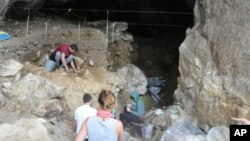A new study suggests Neanderthals formed small, close communities where females may have traveled to move in with their mates.
The research used genetic investigation to offer an idea of Neanderthal family life — including a father and his daughter who lived in Siberia more than 50,000 years ago.
Researchers were able to pull DNA out of tiny bone pieces found in two Russian caves. In their study, which appeared recently in the publication Nature, they used genetic data to map out relationships between 13 different Neanderthals and get information about how they lived.
Bence Viola of the University of Toronto helped write the study.
“When I work on a bone or two, it’s very easy to forget that these are actually people with their own lives and stories,” Viola said. He added, “Figuring out how they’re related to each other really makes them much more human.”
The Neanderthals, our ancient relatives, lived across Europe and Asia for hundreds of thousands of years. They died out around 40,000 years ago, shortly after our species, Homo sapiens, arrived in Europe from Africa.
Scientists have only recently been able to study these early humans’ DNA. New Nobel prize winner Svante Paabo — who was one of the writers of this latest study — published the first study of a Neanderthal genome more than 10 years ago.
Since then, scientists have sequenced 18 Neanderthal genomes, said study lead writer Laurits Skov of the Max Planck Institute for Evolutionary Anthropology.
But it is rare to find bones from multiple Neanderthals from the same time and place, he said — which is why these cave discoveries were so special.
“If there was ever a chance to find a Neanderthal community, this would be it,” Skov said.
The caves, located in hills above a river valley, have been a rich source of materials from stone tools to fossil pieces, Viola said. With their view of animals in the valley below, Neanderthals may have used the caves as a hunting stop.
Researchers digging at the caves have found remains from at least 12 different Neanderthals, Viola said. These remains usually come in small bits and pieces — “a finger bone here, a tooth there” — but they’re enough for scientists to get valuable DNA details.
The researchers were able to identify a couple of relatives among the group. Along with the father and daughter, there were two other relatives.
Overall, the study found that everyone in the group had a lot of DNA in common. That suggests that at least in this area, Neanderthals lived in very small communities of 10 to 20 individuals, the authors concluded. But not everyone in these groups stayed together.
Researchers looked at other genetic information from mitochondrial DNA, which is passed down on the mother’s side, and the Y chromosome, which is passed down on the father’s side.
The female side showed more genetic differences than the male side. This suggests females may have moved around more, Skov said. It is possible that when a female Neanderthal found a mate, she would leave home to live with his family.
University of Wisconsin anthropologist John Hawks, who was not involved in the study, said the research was an exciting use of ancient DNA evidence, even as many questions remain about Neanderthal social structures and lifestyles.
Figuring out how early humans lived is like “putting together a puzzle where we have many, many missing pieces,” Hawks said. But this study means there are “more pieces on the table.”
I’m John Russell.
Maddie Burakoff reported on this story for the Associated Press. John Russell adapted it for VOA Learning English.
________________________________________________________________________
Words in This Story
DNA -- n. a substance that carries genetic information in the cells of plants and animals
actually – adv. used to stress that a statement is true especially when it differs in some way from what might have been thought or expected
species – n. biology : a group of animals or plants that are similar and can produce young animals or plants :
sequence – v. to determine the order in which things happen
puzzle – n. an image made of many small pieces that are cut into various shapes and can be fit together to form a picture











Forum